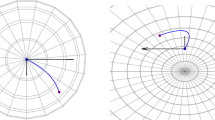Abstract
The question of the existence and correct form of equations describing Brownian motion on a manifold cannot be answered by mathematics alone, but requires a study of the underlying physics. As in classical mechanics, manifolds enter through the transformation of variables needed to account for the presence of constraints. The constraints are either due to a physical agency that forces the motion to remain on a manifold, or they represent conserved quantities of the equation of motion themselves. Also the Brownian motion is described either by a Smoluchowski diffusion equation or by a Kramers equation. The four cases lead to the following conclusions, (i) Smoluchowski diffusion with a conserved quantity reduces to a diffusion equation on the manifold; (ii) The same is true for diffusion with a physical constraint in three dimensions, but in more dimensions it may happen thatno autonomous equation on the manifold results; (iii) A Kramers equation with a conserved quantity reduces to an equation on the manifold, but in general not of the form of a Kramers equation; (iv) The Kramers equation with a physical constraint reduces to an autonomous Kramers equation on the manifold only for a special shape of that constraint. Throughout, only a certain type of physical constraints has been envisaged, and global questions are ignored. Finally, the customary heuristic construction of a Fokker-Planck equation for a mechanical system on a manifold is demonstrated for the case of Brownian rotation of a rigid body, and its shortcomings are emphasized.
Similar content being viewed by others
References
J. d'Alembert,Traité de Dynamique (Paris, 1743).
J.-L. Lagrange,Mécanique Analytique (Paris, 1788).
V. I. Arnold,Mathematical Methods of Classical Mechanics (Springer, New York, 1978); R. Abraham and J. E. Marsden,Foundations of Mechanics, 2nd ed. (Benjamin/Cummings, Reading, Massachusetts, 1978).
H. Rubin and P. Ungar,Commun. Pure Appl. Math. 10:65 (1957); H. Koppe and H. Jensen,Sitzungsber. Heidelb. Akad. Wissens. Math.-Phys. Klasse, 5 Abh. (Springer, Berlin 1971); N. G. van Kampen and J. J. Lodder,Am. J. Phys. 52:49 (1984).
P. A. M. Dirac,Can. J. Math. 2:129 (1950); D. Dominici, G. Longhi, J. Gomis, and J. M. Pons,J. Math. Phys. 25:2439 (1984).
E. G. C. Sudarshan and N. Mukunda,Classical Dynamics: A Modern Perspective (Wiley, New York, 1974); K. Sundermeyer,Constrained Dynamics, Lecture Notes in Physics No. 169 (Springer-Verlag, Berlin, 1982); N. Mukunda, H. van Dam, L. C. Biedenharn,Relative Models of Extended Hadrons Obeying a Mass-Spin Trajectory Constraint, Lecture Notes in Physics No. 165 (Springer-Verlag, Berlin, 1982) Chap. 5.
K. Itô,Nagoya Math. J. 1:35 (1950); H. P. McKean Jr.,Stochastic Integrals (Academic Press, New York, 1969), p. 90; K. D. Elworthy,Stochastic Differential Equations on Manifolds, London Mathematical Society Lecture Note Series 70 (Cambridge University Press, Cambridge, 1982); M. van den Berg and J. T. Lewis,Bull. Land. Math. Soc. 17:144 (1985).
P. Debye,Polare Molekeln (Hirzel, Leipzig, 1929); R. A. Sack,Proc. Phys. Soc. B70:402 and 414 (1957); P. S. Hubbard,Phys. Rev. A6:2421 (1972) andA15:329 (1977); A. Morita, S. Walker, and J. H. Calderwood,J. Phys. D9:2485 (1976); G. W. Ford, J. T. Lewis, and J. McConnell, Phys. Rev.A19:907 (1979); G. Wyllie,Phys. Rep. 61:327 (1980); E. Praestgaard and N. G. van Kampen,Molecular Physics 43:33 (1981).
U. Steiger and R. F. Fox,J. Math. Phys. 23:296 (1982); U. R. Steiger,Physica 125A:1 (1984).
R. Graham,Z. Phys. B26:397 (1977); H. Risken,The Fokker-Planck Equation, Methods of Solution and Applications (Springer-Verlag, Berlin, 1984) p. 88.
A. Einstein,Ann. Phys. (4)17:549 (1905); M. v. Smoluchowski,Ann. Phys. (4)21:756 (1906).
Lord Rayleigh,Phil. Mag. 32:424 (1891) orScientific Papers III (University Press, Cambridge, 1902) p. 473.
P. Langevin,Comp. Ren. (Paris) 146:530 (1908).
G. E. Uhlenbeck and L. S. Ornstein,Phys. Rev. 36:823 (1930) and reprinted inSelected Papers on Noise and Stochastic Processes, N. Wax, ed. (Dover, New York, 1954).
F. Zernike,Handb. Phys. 3, H. Geiger and K. Scheel, eds. (Springer-Verlag, Berlin, 1928) p. 458; C. T. J. Alkemade, N. G. van Kampen, and D. K. C. MacDonald,Proc. Roy. Soc. A271:449 (1963); M. R. Hoare inAdvances in Chemical Physics 20, I. Prigogine and S. A. Rice, eds. (Wiley-Interscience, New York, 1971).
H. A. Kramers,Physica 7:284 (1940) orCollected Scientific Papers (North-Holland, Amsterdam, 1956) p. 754.
O. Klein,Arkiv Mat. Astr. Fys. 16: no. 5 (1922).
M. Herzberger,Modern Geometrical Optics (Interscience, New York 1958); Yu. A. Kravtsov and Yu. I. Orlov,Geometrical Optics in Inhomogeneous Media (Nauka, Moscow, 1980) in Russian.
S. M. Golynski and N. G. van Kampen,Phys. Lett. 102A:220 (1984).
N. G. van Kampen,Phys. Rep. 124:69 (1985).
U. M. Titulaer,Physica 91A:312 (1978);100A:234 and 251 (1980); C. W. Gardiner,Handbook of Stochastic Methods for Physics, Chemistry and the Natural Sciences (Springer-Verlag, Berlin, 1983) p. 195;Phys. Rev. A29:2814 (1984).
J. Meixner,Z. Physik 149:624 (1957).
N. G. van Kampen,Stochastic Processes in Physics and Chemistry (North-Holland, Amsterdam, 1981) p. 296.
D. K. C. MacDonald,Phys. Rev. 108:541 (1957); N. G. van Kampen inFluctuation Phenomena in Solids, R. E. Burgess, ed. (Academic Press, New York, 1965).
N. G. van Kampen inAdvances in Chemical Physics 34, I. Prigogine and S. A. Rice, eds. (Wiley, New York, 1976).
D. Dürr, S. Goldstein, and J. L. Lebowitz,Z. Wahrs. verw. Geb. 62:427 (1983).
Author information
Authors and Affiliations
Rights and permissions
About this article
Cite this article
van Kampen, N.G. Brownian motion on a manifold. J Stat Phys 44, 1–24 (1986). https://doi.org/10.1007/BF01010902
Received:
Revised:
Issue Date:
DOI: https://doi.org/10.1007/BF01010902




